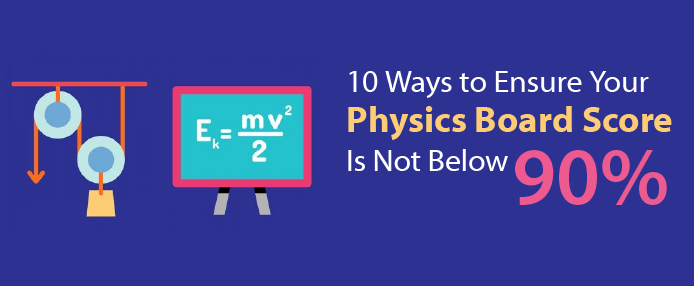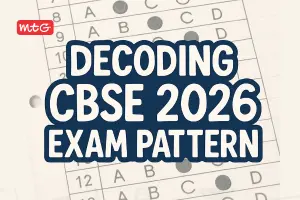Physics is one of the fundamental subjects in Science that deals with various concepts and mathematical expressions. Since Boards are nearing closer, you must have well prepared for your Physics paper. To learn Physics, you should understand the concepts in-depth and able to solve a number of concept-based numericals.
According to newly released CBSE Sample papers , the percentage for difficult questions is estimated to be 15% in the class 12th Physics Board Paper. Hence, only 15% of questions are going to be difficult this year, giving you a better chance to score high. With very less time in hand, you have to revise your syllabus smartly. To help you in your last 3 months preparation time, we are providing here 10 powerful tips to score high in class 12th Physics Board Paper.
Class 12th Physics Board Paper is divided into 10 units with different weightages. Though questions can be asked from any section of the syllabus, keeping time availability in mind, it would be wise to concentrate on important theories, concepts, formulae and derivations. Here’s the list of chapters with the weightage of marks given to them in the class 12th Physics Board Paper:
Read it carefully and understand the areas where you need to emphasize more in order to finish your preparation in the limited period of time and score high in your Physics Paper.
Unit 1: Electrostatics (08 marks)
Revise: SI units and dimensions of electric charge, field, dipole moment, flux and charge densities, potential, capacitance and polarisation. Drawing field lines and EPS for dipole, two charge and single charge system.
Vector form of Coulomb’s Law. Gauss Theorem, electric dipole, electric field lines and equipotential surface. capacitor, Van de Graff Generator
Remember: Charge is scalar but the electric field created by it is a vector, whereas the potential is again a scalar. Electric flux is a scalar. A dipole experiences no force but pure torque in uniform electric field whereas it does experience a force and torque both in non-uniform field. Gauss’s Law is valid only for closed surfaces. Three types of charge densities viz linear, surface and volume are different physical quantities having different unit and dimensions. Along a field line, potential decreases at the fastest rate. The dipole moment per unit volume is called polarisation and is a vector. Whether it’s a solid or a hollow conducting sphere, all free charges reside on its surface. Dielectric constant is also called relative permittivity and is dimensionless, unitless.
Unit 2: Current electricity (07 marks)
Revise:SI units and dimensions of mobility, resistance, resistivity, conductivity, current density and emf. Ohm’s Law, drift velocity, colour coding. Parallel/ series combination of cells. Potentiometer. Numericals on finding equivalent resistance/current using Kirchoff’s laws
Remember: Current is scalar as it does not follow laws of vector addition but current density is vector. Kirchoff’s junction/ loop law is charge/ energy conservation laws. If the Galvanometer and cell are interchanged in balanced Wheatstone bridge, the balance does not get affected. For a steady current along a tapering conductor, current remains constant but current density, drift speed and electric field varies inversely as area of cross-section. Ohm’s law is not universally applicable such as vacuum diode, semiconductor diode.
Unit 3: Magnetic effects of current and magnetism: (08 marks)
Revise: SI units and dimensions of permeability, relative permeability, magnetic moment, field, flux, intensity, susceptibility, torsional constant and their nature as vector or scalars. Magnetic field lines. Biot-Savart and Ampere’s law, solenoid, toroid, MCG, Cyclotron, para/ dia/ferro magnetism, permanent magnets and electromagnets. Numericals on ammeter and voltmeters
Remember:Parallel currents attract and anti-parallel currents repel. Ampere’s law can be derived from Biot- Savart’s law. MCG has two sensitivities voltage and current as deflection per unit voltage/ current, respectively. Angle of dip is also called inclination, its value at poles and at equator are 90 degrees and 0 degree, respectively.
Superconductors are perfect diamagnets. T(tesla) is SI unit for magnetic field, the other being G (Gauss, non-SI), 1 T is equal to 10,000 Gauss.
Diamagnetism is universal – it is present in all materials.
Unit 4: EMI and AC (08 marks)
Revise: SI unit and dimensions of self and mutual inductance, capacitive and inductive reactance, impedance, Q-factor, power factor. Faraday’s/ Lenz’s law, eddy current, motional emf, self/ mutual inductance, AC generator, transformer
Remember: Lenz’s law is consequence of energy conservation. Eddy current has merits and demerits. AC is scalar but follows phasor treatment as it is periodically varying. At resonance power factor is 1, hence maximum power is dissipated. A transformer works in AC but not in DC. The power consumed in an AC circuit is never negative. Rated values of ac devices for current and voltages are rms whereas for power it is average. Higher the Q-factor sharper the resonance, smaller the bandwidth and better the selectivity
Unit 5: Electromagnetic waves (03 marks)
Revise:Properties and frequencies, Ampere-Maxwell law, displacement current, drawing of EMW. Numericals on finding frequency, speed etc from given equation.
Remember: An oscillating charge produces EMW of the frequency of oscillation. IR waves are also called heat waves as they produce heating. The AM (amplitude modulated) band is from 530 kHz to 1710 kHz. TV waves range from 54 MHz to 890 MHz. The FM (frequency modulated) radio band extends from 88 MHz to 108 MHz. TV remote uses IR waves. LASIK and water purification use UV rays.
Unit 6: Optics (14 marks)
Revise: Lens and Lens maker’s formula, magnifying and resolving power, limit of resolution, Hygen’s principle and polarisation, YDSE. Numericals on image location and its nature for lens-mirror combinations
Remember: Resolving power is inverse of limit of resolution. Unpolarised light after passing through a polaroid gets linearly polarised with half the intensity for any orientation of the polaroid. Diffraction, interference and polarisation prove the wave nature of light. Polarisation proves the transverse nature of light. Compound microscope has eyepiece of larger aperture and objective smaller vice versa in a telescope. Reflecting telescope removes chromatic and spherical aberration fairly. If the source of light is white in YDSE the central fringe is white and others are coloured in sequence from nearest red to the farthest blue.
Unit 7: Dual nature of matter and radiation (04 marks)
Revise: Einstein’s photoelectric equation and all the graphs in the NCERT book. Davisson-Germer experiment. Numericals based on de Broglie’s and photoelectric equations.
Remember: de Broglie equation relates particle to wave. Wave nature of electrons are used in electron microscope. Photoelectric effect was explained using photon picture of light.
Unit 08: Atoms and nuclei (06 marks)
Revise: Bohr model, scattering experiment. Radioactive decay laws, BE and BE per nucleon, isotopes, isobars, fusion and fission.
Remember: Rutherford’s model of atom is called planetary/nuclear model. The n value for first excited state in Bohr’s equation is 2 and not 1. Bohr model is only applicable to hydrogen/hydrogen-like atoms. All radioactive decay follows first order kinetics. Beta decay corresponds to both plus/minus beta decay releasing neutrino/antineutrino, respectively. Alpha decay increases n/p ratio. Nuclear reactors use fission reaction for producing powers. Source of energy in sun/stars is nuclear fusion.
Unit 9: Electronic devices (07 marks)
Revise: Diode as full and half wave rectifier. Zener diode as voltage regulator. Transistor as switch, amplifier, oscillator, Logic gates.
Remember: The order of thickness of depletion layer is one-tenth of a micrometre. Zener diode cannot regulate AC. Si and GaAs are used in solar cells. Full wave rectification doubles the frequency of the input whereas half wave does not change. An oscillator uses positive feedback. NAND and NOR gates are called universal gates.
Unit 10: Communication system (05 marks)
Revise: Various frequency range tables, need for modulation, AM wave production and detection and derivation of relation between radio horizon and antenna height.
Remember: Mobile telephones operate typically in the UHF range of frequencies (about 800-950MHz). In modulation, some characteristics of the carrier signal like amplitude, frequency, or phase varies. Space waves are used for line-of-sight (LOS) communication as well as satellite communication.
Apart from studying smartly from these chapters, it is equally important to draw relevant graphs and diagrams (schematic, circuit and Ray) for revising the topics and to give the final touch-up to your preparations.
We hope these tips will make your last 3 months preparation for class 12th Physics Board Paper easier. Since exams are nearing, practice from the best sources of Physics Books. MTG brings a wide range of CBSE books to practice for the upcoming Boards. Solve sample papers and practice Previous Years’ Papers to check your preparedness and to learn proper time management during the real exam. You may also like to read our article on 7 Best known Tips that can make you better at Physics Problems .
Related Article: How to score 80% in Class 12th Board Exams by studying in 3 months
All the Best 😊
Contributed By: Krishna Deo Pandey, Physics Expert.

































